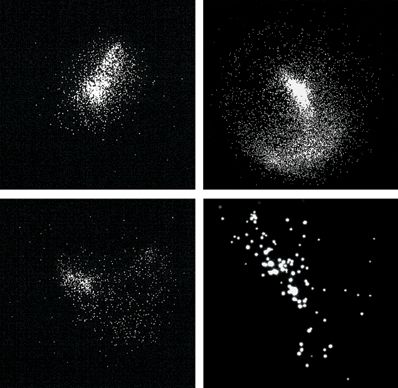A Better Way to Profile Your Ion Beam in Instrument Design for More Accurate Analysis
The Application Notebook
Photonis has combined two of our superior detection and analysis technologies into a new digital ion beam profiling unit. The new Ion Beam Profiler combines a large microchannel plate (up to 120 mm) in a complete assembly with the Photonis Nocturn, a high-resolution digital CMOS low-light camera which is immune to sudden light damage.
Photonis has combined two of our superior detection and analysis technologies into a new digital ion beam profiling unit. The new Ion Beam Profiler combines a large microchannel plate (up to 120 mm) in a complete assembly with the Photonis Nocturn, a high-resolution digital CMOS low-light camera which is immune to sudden light damage. Together these highly sensitive imaging components offer a detailed image of your instrument's ion beam, allowing system designers to identify and correct any areas of ion loss that had previously been overlooked. This new diagnostic tool allows the instrument to be designed to maximize the amount of ions collected for a superior analysis.
Tracing the Path
Ion optics modeling software is often used to design and predict the ion path within a mass spectrometer. The conventional method for aligning an ion beam consists of scanning the beam over a Faraday cup or electron multiplier, integrating the current, and finding the settings which produce the highest signal. However, ion trajectories can be influenced by many factors which are not considered in the model. Efficiently transporting ions from the source through the mass filter is critical for maximizing instrument sensitivity.
The new Photonis Ion Beam Profiler can visualize the location of any charged particle (ion, electron, UV, photon, or soft X-ray), enabling the instrument designer to ensure all available signal ions are collected. The unit can capture images from the phosphor screen at rates up to 100 frames per second and store them on a PC for collaboration and comparison testing. A strobe trigger is available to synchronize the camera to a specific event. The unit can also be used as a real-time tuning device, allowing an instrument designer to receive immediate feedback on the focus, alignment, and trajectory of the ion beam, and can also show any obstructions in the pathway, such as a loose wire (Figure 1).

Figure 1: Actual images taken of the ion beam during ion optimization process. Top left shows a well-focused beam; top right shows a poorly focused beam. Bottom left shows a defocused beam while bottom right demonstrates a close up of a region of interest.
Connectivity Options
The Nocturn camera provided with the Ion Beam Profiler can be ordered with a variety of connectivity options for simple video analysis, including GigE Vision®, USB3 GenICam®, USB, CameraLink® compatible, or analog NTSC or PAL. Some models are also offered with a color video sensor, which can provide color video at higher light levels and monochrome images at light levels less than 100 mlx to eliminate color noise from the image.
Versatile Applications
The new Ion Beam Profiling unit can be used in wide range of applications, including ion optic model verification, imaging TOF, VUV spectroscopy, and high energy physics as well as ion beam profiling. The unit can be custom-fit with a specific microchannel plate and electro-optic housing to fit your unique application.

Photonis USA
660 Main Street, Sturbridge, MA 01566
tel. (508) 347-4000
Website: www.photonis.com

Free Poster: NDSRI Risk Assessment and Trace-Level Analysis of N-Nitrosamines
April 25th 2025With increasing concern over genotoxic nitrosamine contaminants, regulatory bodies like the FDA and EMA have introduced strict guidelines following several high-profile drug recalls. This poster showcases a case study where LGC and Waters developed a UPLC/MS/MS method for quantifying trace levels of N-nitroso-sertraline in sertraline using Waters mass spectrometry and LGC reference standards.
New TRC Facility Accelerates Innovation and Delivery
April 25th 2025We’ve expanded our capabilities with a state-of-the-art, 200,000 sq ft TRC facility in Toronto, completed in 2024 and staffed by over 100 PhD- and MSc-level scientists. This investment enables the development of more innovative compounds, a broader catalogue and custom offering, and streamlined operations for faster delivery. • Our extensive range of over 100,000 high-quality research chemicals—including APIs, metabolites, and impurities in both native and stable isotope-labelled forms—provides essential tools for uncovering molecular disease mechanisms and exploring new opportunities for therapeutic intervention.
New Guide: Characterising Impurity Standards – What Defines “Good Enough?”
April 25th 2025Impurity reference standards (IRSs) are essential for accurately identifying and quantifying impurities in pharmaceutical development and manufacturing. Yet, with limited regulatory guidance on how much characterisation is truly required for different applications, selecting the right standard can be challenging. To help, LGC has developed a new interactive multimedia guide, packed with expert insights to support your decision-making and give you greater confidence when choosing the right IRS for your specific needs.
Using the Carcinogenic Potency Categorisation Approach (CPCA) to Classify N-nitrosamine Impurities
April 25th 2025Learn how to manage nitrosamine impurities in pharmaceuticals with our free infographic. Discover how the CPCA approach establishes acceptable intake limits and guides the selection of NDSRI reference samples. Stay compliant and ensure safety with our ISO-accredited standards.

.png&w=3840&q=75)

.png&w=3840&q=75)



.png&w=3840&q=75)



.png&w=3840&q=75)











